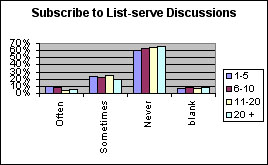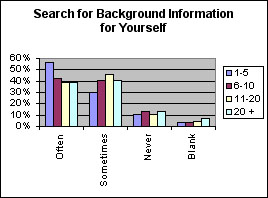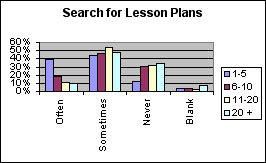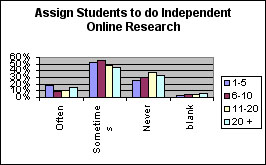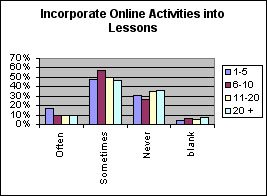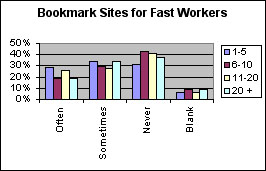![]()
![]()
![]()
![]()
![]()
![]()
![]()
![]()
![]()
![]()
![]()
When is the next
Museums and the Web?
![]()
Archives &
Museum Informatics
158 Lee Avenue
Toronto, Ontario
M4E 2P3 Canada
info@ archimuse.com
www.archimuse.com
| |
Search
A&MI |
Join
our Mailing List.
Privacy.
Copyright
Archives & Museum Informatics
2000
From the Horse's Mouth: How Our Teachers are Using the Internet
Abstract
With Internet access in schools rapidly becoming the norm, it could be said the "horses" are at the waterñbut are they drinking? In the fall of 1999, we polled 750 elementary and secondary teachers in our local audience about their online habits as part of a larger inquiry into what formats teachers are currently using to present visual materials to their students. Our survey asked them to rate how frequently they use the internet in a variety of ways, ranging from checking e-mail to searching for lesson plans to incorporating online activities in their lessons. Almost nine out of ten teachers reported some degree of Internet use, most commonly checking e-mail. A surprisingly high number reported incorporating the Internet into their lesson preparation and student assignments. These results should cheer technology promotersñmost of our teachers are at least sipping from the waters of the Internet. We now have a chance to apply what we have learned about teachers' habits to provide them with applications that meet their current comfort levels and encourage them to do still more.
Introduction
In September of 1998 the Minneapolis Star Tribune ran an article headlinedTechnology Abounds in Minnesota Schools.It was inspiring to learn that is a national leader percentage schools wired Internet. But while and others since have boasted average student-to-computer ratio less than 5 students per computer they leave unanswered questions how access translates into practice. Are teachers reallyusing all those computers? What doing with them? should proliferation Internet impact TYPE teacher materials we produce? Would fail our core audience by presuming certain level comfort? be designing foror use directly their students? Do different segments (elementary high school art general classroom subjects) habits? younger future educational system differently older teachers?
We sought insight into these questions through a survey asking teachers about their habits of presenting visual materials to their students. While many of the formats we asked about were the traditional ones used by museum education departments (slides, videos, postcards, posters, etc.), we included computer formats in the mix as well. We then asked teachers which of the formats we listed they would prefer us to provide as tools for teaching. And finally, we included a question about the frequency with which they use the Internet in a variety of ways, activities characteristic of a range of comfort levels. (See Appendix 1 for the survey.)
Teachers completed the one-page survey on two occasions, the Education Minnesota teacher conference (October 21, 1999) and the Institute's free open house for teachers, Educators' Evening (November 8, 1999). At the conference, teachers received a packet of 16 postcards for their participation. At Educators' Evening, the survey was on the back of the event evaluation form that was turned in exchange for a free poster.
|
Grade level and subject taught |
Education |
Educators' |
Total |
|
K-6 Art |
15 (4%) |
106 (18%) |
121 (13%) |
|
K-6 Classroom |
150 (42%) |
172 (30%) |
322 (35%) |
|
7-12 Art |
12 (3%) |
120 (21%) |
132 (14%) |
|
7-12 Classroom |
70 (20%) |
101 (18%) |
171 (18%) |
|
College |
0 (0%) |
1 (0%) |
1 (0%) |
|
Student Teacher |
48 (13%) |
2 (0%) |
50 (5%) |
|
Other |
56 (16%) |
65 (11%) |
121 (13%) |
|
Blank |
7 (2%) |
6 (1%) |
13 (1%) |
|
TOTAL |
358 |
573 |
931 |
Of the 931 total responses, 746 of the respondents were part of our core audience of elementary and secondary art and general classroom teachers. Of those, 16% (121) taught K-6 Art; 43% (322) taught K-6 Classroom; 18% (132) taught 7-12 Art; and 23% (171) taught 7-12 Classroom.
Question 1: Presentation Habits
See Appendix 2 [djohnson2.doc] for charts comparing responses to the question, "How often do you present visual materials to your students in the following ways?" The table below summarizes the percentage of teachers who reported using the various formats often or occasionally:
|
K-6 Art |
K-6 Classroom |
7-12 Art |
7-12 Classroom |
Overall |
|
|
Photocopies |
83% |
85% |
80% |
87% |
84% |
|
Postcards |
73% |
50% |
73% |
51% |
58% |
|
Posters |
98% |
95% |
95% |
90% |
94% |
|
Overheads |
59% |
75% |
52% |
82% |
70% |
|
Slides |
74% |
35% |
79% |
40% |
50% |
|
Videos |
81% |
78% |
86% |
87% |
82% |
|
Hands-on kits |
40% |
72% |
30% |
51% |
55% |
|
CD Roms |
31% |
59% |
36% |
35% |
45% |
|
Internet sites |
40% |
55% |
57% |
59% |
54% |
|
Classroom computer |
45% |
77% |
58% |
64% |
65% |
|
Computer projector |
21% |
30% |
30% |
28% |
28% |
|
Computer lab |
34% |
67% |
48% |
65% |
58% |
Significant observations can be made about teachers' presentation habits. Among them:
- There is great variation in the frequency with which teachers use slides, traditionally the backbone of many art museums' resources for teachers. More art teachers use them frequently than classroom teachers do. (74% K-6 Art and 79% 7-12 Art vs. 35% K-6 Classroom and 40% 7-12 Classroom) Slides were called unavailable by 4% of teachers overall, most of them K-6 classroom teachers.
- The rate of use of Internet sites, a novel format, compares in surprising ways with the use of slides, a traditional format. Again, there is great variation in the frequency with which teachers use Internet sites, depending upon the subject and level they teach. Classroom teachers are the most frequent users of computer formats, at higher rates than they use slides. (See below for more detail on teachersí Internet habits.)
Question 2: Format Preferences
Teachers' stated presentation habits did not correspond entirely with their expressed preference for materials to be made available by the museum as a teaching tool. The following table summarizes the percentage of teachers who expressed an interest in each of the various formats:
|
K-6 Art |
K-6 Classroom |
7-12 Art |
7-12 Classroom |
Overall |
|
|
Videos |
61% |
59% |
71% |
63% |
62% |
|
Posters |
64% |
57% |
53% |
47% |
55% |
|
Slides |
49% |
37% |
62% |
33% |
42% |
|
Kits |
23% |
47% |
26% |
38% |
38% |
|
CD Roms |
31% |
35% |
32% |
37% |
34% |
|
Overheads |
23% |
36% |
24% |
40% |
32% |
|
Internet sites |
32% |
28% |
26% |
37% |
30% |
|
Postcards |
30% |
26% |
26% |
23% |
26% |
|
Photocopies |
15% |
19% |
9% |
22% |
17% |
All groups named videos, posters, slides, and hands-on resource kits with greatest frequency. Among the greatest discrepancies between reported presentation habits and preferences occurs around Internet sites. In the case of the Internet, a new format, teachers may not be able to visualize what the museumís offerings might look like.
Question 3: Internet habits
The survey asked teachers to rate the frequency with which they use the Internet in eight different ways.
- Check e-mail
- Subscribe to list-serve discussions
- Search for background information for yourself
- Print out information to provide to students
- Search for lesson plans
- Assign students to do independent online research
- Incorporate online activities into lessons
- Bookmark sites for fast workers
Some activities, like checking e-mail, require minimal sophistication but indicate a requisite level of access to the Internet and comfort in doing so. Others activities, like searching for lesson plans and finding background information for oneself, are more advanced but require a lower degree of integration into the classroom than activities such as assigning students to do independent research or making online activities a part of a lesson.
See Appendix 3 for charts representing teachers' responses to the question, "How often do you use the Internet in the following ways?" Findings of interest include:
- Most teachers (88%) reported using the Internet to some degree, the most common activity being checking e-mail.
- Teachers more frequently use the Internet to prepare to teach (searching for background information or lesson plans, or printing out information to hand out to students) than ask their students to use the Internet or incorporate online activities into their lessons.
- Usage habits are fairly evenly distributed across the different audience groups, although K-6 classroom teachers more frequently engage their students with the Internet directly.
- Teachers with 1-5 years' experience are more likely to use the Internet often than older teachers. Teachers with 6-10, 11-20, or more than 20 years experience use the Internet at relatively similar rates. (See Appendix 4 [djohnson4.doc] for a breakdown of responses grouped by years of experience.)
- Few teachers subscribe to list-serve discussions.
- 349 teachers named (or described) favorite educational web sites. Common responses include, in no particular order, the Getty's ArtsEdNet, AskEric educational database, the Minneapolis Star Tribune, the MIA, ArtsConnectEd, NASA, Kathy Schrock's Scholastic Instructor, PBS, Smithsonian, Electronic Classroom, Scholastic News, National Geographic, Discover online, Wall Street Journal, MNHS, travel tracking, Yahooligans, Ask Jeeves for Kids, and the Library of Congress
Conclusions
Do these results get us any closer to answering the questions enumerated at the start? Let's address them one by one.
- Are teachers really using all those computers?
Yes. Almost nine out of ten teachers reported checking e-mail, about as close as we came to a unanimous answer on the whole survey. This result by no means implies a mass of sophisticated computer users, but it does indicate that the majority of teachers have access to an Internet connection and at least know how to turn the computer on.
- What are they doing with all those computers?
Teachers are applying the Internet to their work in a range of ways beyond checking e-mail. While more teachers use the Internet as a source of background information for themselves and for their students, over half of the teachers integrate it into their lessons and assignments at least sometimes.
- How should the proliferation of Internet access impact the type of teacher materials we produce?
Teachers express a preference for traditional formats that cannot be ignored; we should not abandon traditional formats altogether in the near future. However, their self-reported presentation habits should give us the confidence that they will use Internet resources that are designed with teacher habits in mind if we communicate how to use them. I believe that rather than creating resources that are wholly traditional or wholly internet-based, we should be thinking in terms of developing "hybrid" formats that lure users of traditional formats to use internet resources in tandem with traditional types of resources.
- Would we fail our core audience of teachers by presuming a certain level of Internet comfort?
Yes and no. We should not abandon the formats teachers are used to using and still ask for resoundingly. But we this survey demonstrates that most teachers are using the Internet at some level. We can expand their resource options by recognizing the different ways that teachers are using the Internet and design our offerings to make it easy for them to choose do those things they are comfortable doing and not to do others. Participation at a lower level will embolden them to try other things in the future. We should put as much energy into communicating with teachers how they can use our Internet resources as we do into designing them in the first place.
- Should we be designing materials for teachers, or for use directly by their students?
Teachers are more likely to use the Internet as a source for background information for themselves or as a source for lesson ideas than send their students to the Internet directly. While we should build in components that are intended for student use, we limit our users to that smaller subset of teachers with sufficient comfort to incorporate the internet directly into their classrooms if that is all we do.
- Do the different segments of our core audience (elementary and high school teachers of art and general classroom subjects) have different habits?
Yes. Classroom teachers are clearly more accustomed to finding their resources on the Internet than art teachers are. This finding suggests exciting opportunities to integrate study of the arts into regular classroom studies. But it also makes clear the need for us to target the needs of art teachers as we teach our audience about the Internet resources we make available and how to use them.
- Are younger teachers, the future of the educational system, using the Internet differently than older teachers?
Yes. However, the difference occurs more in degree of frequency than in participation. Teachers with 1 to 5 years of experience report that they "often" use the Internet more than other groups, which tend more towards "sometimes." This trend will only increase as more teachers come of age having used the Internet in their own studies, as professional development opportunities proliferate, and as more quality resources are available. It will take similar surveys five and ten years down the road to reevaluate the course suggested by this snapshot of how our teachers are using the Internet today.
Appendix 1: Survey Form
Survey of Teacher Preferences
School: ________________________ District: _________________________
Grade(s) taught: ________________ Subject(s) taught: __________________
Years teaching: O 1 - 5 years O 6 - 10 years O 11 - 20 years O 20 or more years
1. How often do you present visual material to your students in the following ways?
|
Often
|
Occasionally
|
Rarely
|
Never
|
Not available
|
|
| 1. Photocopies |
O
|
O
|
O
|
O
|
O
|
| 2. Postcards |
O
|
O
|
O
|
O
|
O
|
| 3. Posters |
O
|
O
|
O
|
O
|
O
|
| 4. Overhead transparencies |
O
|
O
|
O
|
O
|
O
|
| 5. Slides |
O
|
O
|
O
|
O
|
O
|
| 6. Videos |
O
|
O
|
O
|
O
|
O
|
| 7. Hands-on resource kits |
O
|
O
|
O
|
O
|
O
|
| 8. CD Roms |
O
|
O
|
O
|
O
|
O
|
| 9. Internet sites |
O
|
O
|
O
|
O
|
O
|
| 10. Classroom computer |
O
|
O
|
O
|
O
|
O
|
| 11. Computer projector |
O
|
O
|
O
|
O
|
O
|
| 12. Computer lab |
O
|
O
|
O
|
O
|
O
|
Other ways? _________________________________________________
- Of items 1 - 9 above, which would you most
like the Institute to make
available as a teaching tool? Write your choices on the blanks below in order of preference.
1. ____________________ 4. _____________________
2. ____________________ 5. _____________________
3. ____________________
3. How often do you use the internet to Ö
Check e-mail? O often O sometimes O never
Subscribe to list-serve discussions? O often O sometimes O never
Search for background information for yourself? O often O sometimes O never
Print out information to provide to students? O often O sometimes O never
Search for lesson plans? O often O sometimes O never
Assign students to do independent online research? O often O sometimes O never
Incorporate online activities into lessons? O often O sometimes O never
Bookmark sites for fast workers? O often O sometimes O never
4. What are your favorite education-related websites and why? (exact url's not necessary)
_______________________________________________________________________
_______________________________________________________________________
(CODE_________)
Appendix 2
Question 1: How often do you present visual materials to your students in the following ways?
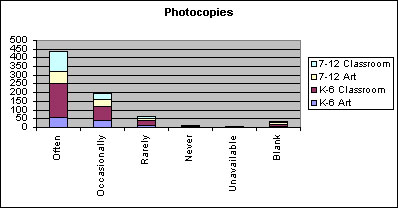

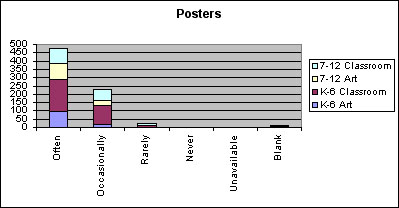
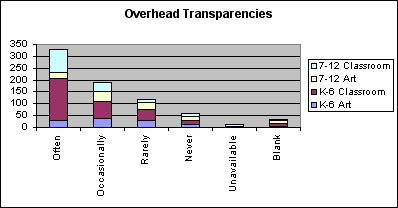
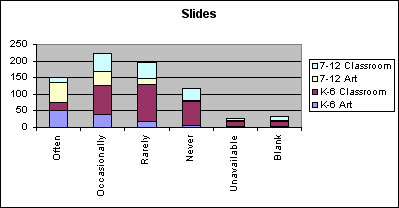
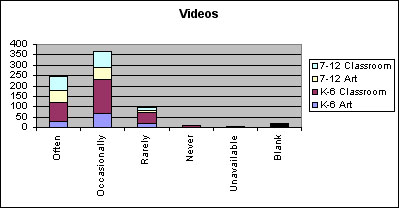
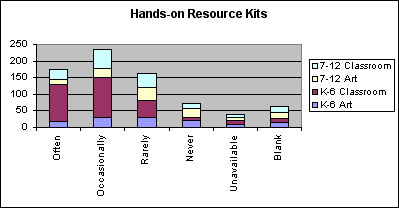
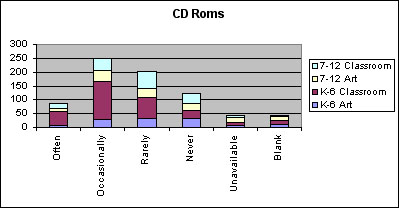
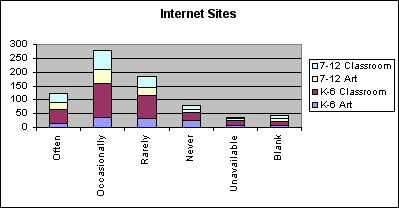


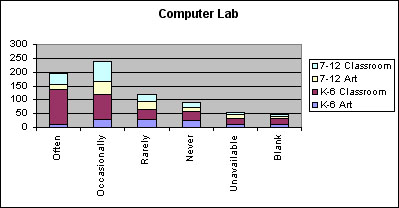
Appendix 3
Question 3: How often do you use the Internet in the following ways?

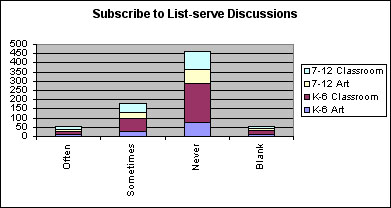
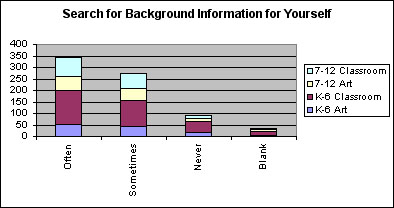

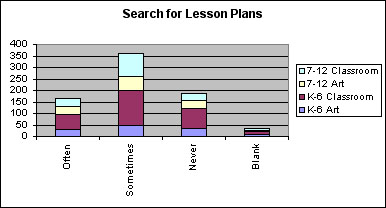


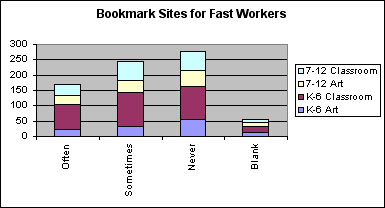
Appendix 4
Question 3: How often do you use the Internet in the following ways? (Responses grouped by number of years teaching.)

